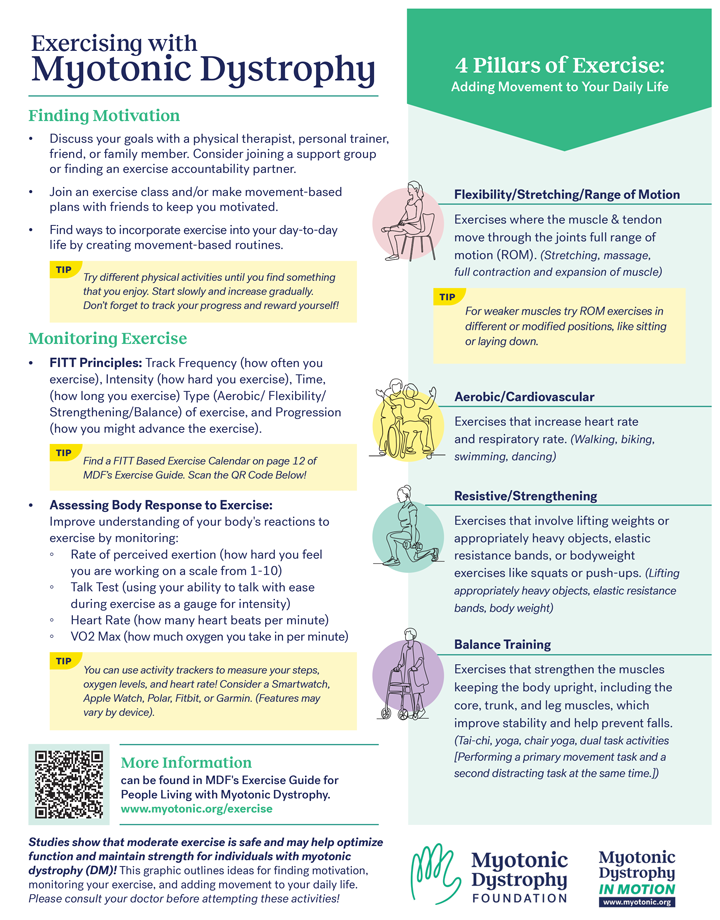Studying Resistance Training in Myotonic Dystrophy
Hot off the press and a great conclusion of Myotonic Dystrophy in Motion awareness month, July 2024! MDF's Chief Scientific Officer, Dr. Andy Rohrwasser, summarizes a study with a focus on resistance training, "Resistance Training in Women with Myotonic Dystrophy Type 1: a Multisystemic Therapeutic Avenue", by Girard-Côté et al, published in the July of 2024 edition of the Neuromuscular Disorders journal.
While there is still no cure for DM1, muscle strengthening holds great potential to improve this multisystemic condition. A recent study in men with DM1 undergoing a 12-week lower limb strength training program showed positive effects including improved lower limb muscle strength and physical capacity. Strength training also reduced the perception of apathy, fatigue and daytime sleepiness with some of those clinical gains even maintained up to 6 months after the end of the training program.
In this current study, led by researchers at the Neuromuscular Diseases Interdisciplinary Research Group (GRIMN), Université Laval, Université de Sherbrooke, University of Quebec at Chicoutimi, the University of Glasgow, the University of Quebec at Trois-Rivières, and the University of Quebec at Montréal, the multisystemic impact of a 12-week lower-limb supervised resistance training program was investigated in women with DM1. The study showed that resistance training had a significant and positive impact on muscle strength and function, pain, as well as apathy and depression.
Interestingly, some of these gains were maintained up to 6 months after the end of the training program. Additionally, the study showed that the participants appreciated the training regimen. The persistence of many positive effects over 6 months after the end of the program suggests that therapy efforts focusing on lower limb muscle strengthening could limit loss of muscle strength and function.
Exercise effect and impact is consistent in male and female patients.
Reference:
Resistance Training in Women with Myotonic Dystrophy Type 1: a Multisystemic Therapeutic Avenue
Neuromuscular Disorders. 2024;40:38-51. doi:10.1016/j.nmd.2024.05.009.
Myotonic Dystrophy & Exercise
MDF wants to help you move! What started as an idea for MDF activewear by community member Luke Bolt and his family has evolved into an MDF care initiative to unify, inspire, and encourage the international DM community to start moving! Click here to learn about Myotonic Dystrophy In Motion!
Check out the featured resources below to learn more about the science behind exercising with myotonic dystrophy and the resources and strategies available for building and maintaining a life in motion!
Exercise Resource Videos
2024 Myotonic Dystrophy In Motion Awareness Month:
- Exercises for Everyday Life (2024): Watch this webinar focusing on incorporating small exercises into your daily routine with MDF Grantee, Kristina Kelly, DPT, University of Missouri-Columbia. Learn about the importance of a balanced movement practice and discover simple movements that can enhance your overall well-being.
- The Benefits of Nature & Breathwork (2024): Explore the connection between nature, wellness, and breathwork with Katy Eichinger, PhD, DPT, University of Rochester, and Payge Purdue, certified yoga and Qigong instructor. Watch this webinar to discover the transformative power of mindfulness and breathwork practices to enhance your daily movement routines.
- Stump the Doctor & Community Panel (2024): Have questions about exercise and myotonic dystrophy? Wondering about strength training or how often you should exercise? Watch this recording with our panel of experts featuring Donovan Lott, Pt, PhD, CSCS, University of Florida, alongside three MDF community members, Ryan Vogels, MDF Support Group Facilitator living with DM2, Margie Singleton, living with DM1, and Luke Bolt, living with DM1.
Exercise for the Myotonic Dystrophy Community (2020): Understanding the importance of exercise is vital for myotonic dystrophy care. Two physical therapists, Dr. Katy Eichinger and Dr. Tina Duong, present information on the benefits of exercise for DM, recommendations on types of exercise, and finding motivation.
Exercise, Nutrition & Speech (2019): This rehabilitation panel featuring Katy Eichinger, PhD, DPT, Leslie Vnenchak, MA, CCC-SLP, and Robin Meyers, RD, MPH, LDN reviews current research and strategies for managing DM symptoms through exercise, speech and nutrition.
Downloadable Exercise Resources
Exercising with Myotonic Dystrophy Infographic: Designed for People Living with DM. Use our brand-new one page guide for fresh ideas to keep your movement practice on point. This resource is applicable to individuals with either myotonic dystrophy type 1 or type 2 and aims to provide guidance on exercise.
Exercise Guide for Individuals with Myotonic Dystrophy: Designed for People Living with DM. This guide is written by two physical therapists who specialize in working with individuals with DM, and includes information on the benefits of exercise for DM, recommendations on aerobic activity, types of exercise, monitoring exercise, exercise strategies and finding motivation.
Nutrition Guide for Individuals with Myotonic Dystrophy: Designed for People Living with DM. This guide is written and reviewed by nutritionists who specialize in working with individuals with DM, and includes information on diet and DM, managing constipation, being overweight/underweight with DM, managing swallowing problems, feeding tubes, supplements, and sample meals.
Resources for Your Physical Therapist
Role of Physical Therapy in the Assessment and Management of Individuals with Myotonic Dystrophy: Designed for Physical Therapists. Most individuals living with myotonic dystrophy (DM) will probably first encounter a physical therapist in the multidisciplinary clinic where they receive care. These physical therapy guidelines for DM address the role that the physical therapist plays in DM care, including evaluation, education, instructions and physical movement recommendations.



